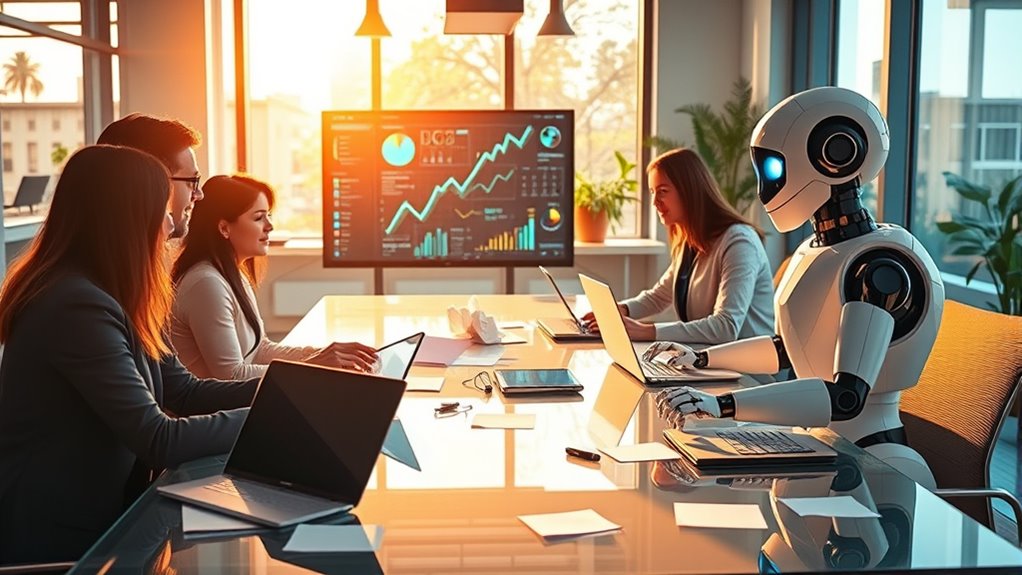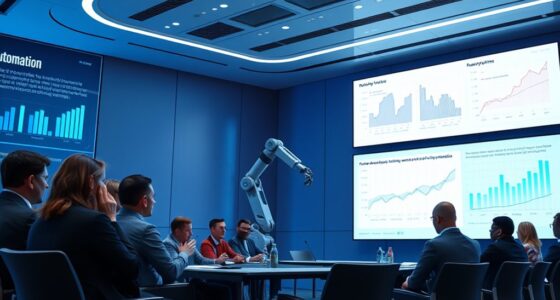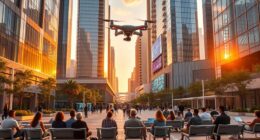Human-AI collaboration is transforming how you work and create, blending bots and people to boost productivity, safety, and innovation. From virtual assistants personalizing your daily tasks to healthcare tools diagnosing faster, these partnerships improve outcomes and make life easier. Creative technologies help you innovate, while autonomous vehicles enhance safety on the road. As these stories unfold, you’ll discover inspiring examples of humans and AI thriving together—continue to explore these exciting collaborations.
Key Takeaways
- AI-powered virtual assistants enhance daily productivity by automating routine tasks and personalizing user experiences.
- In healthcare, AI accelerates diagnostics and supports real-time triage, improving patient outcomes through human-AI collaboration.
- Assistive technologies enable individuals with disabilities to communicate and control devices, restoring independence effectively.
- Mental health chatbots provide accessible, personalized support, augmenting traditional mental health services and crisis intervention.
- Autonomous vehicle systems analyze data for safer navigation, working alongside humans to create smarter, more secure transportation.

Human-AI collaboration is transforming how we work, learn, and care for one another, showcasing powerful stories across diverse fields. These partnerships demonstrate how intelligent systems complement human skills, leading to breakthroughs that improve lives and drive innovation. Whether it’s virtual assistants helping manage daily tasks or AI tools diagnosing complex medical conditions, the synergy between humans and machines is reshaping our world.
Take virtual assistants, for example. They’re now more than simple voice-activated tools; they personalize experiences, automate routine tasks, and support multiple languages, making daily interactions seamless. You might use a virtual assistant to schedule appointments, find information quickly, or get reminders, freeing up your time for more meaningful activities. These assistants learn from your preferences, becoming more intuitive and useful over time, which enhances your productivity and convenience.
Virtual assistants now personalize, automate, and support multiple languages, making daily tasks seamless and boosting productivity.
In healthcare, AI-driven MRI diagnostics are revolutionizing how radiologists analyze scans. AI algorithms help identify anomalies faster and with greater accuracy, reducing errors and expediting diagnoses. For you as a patient, this means quicker treatment plans and personalized care tailored to your specific needs. The collaboration between AI and medical professionals also enables real-time triage during emergencies, ensuring critical cases receive immediate attention, improving outcomes and saving lives. Additionally, predictive modeling in educational data mining supports healthcare providers in anticipating patient needs and optimizing resource allocation, demonstrating the broad impact of AI-driven data analysis.
Assistive computing supports individuals with motor neuron disease (MND) by providing tailored communication aids and motor control assistance. These systems recognize personalized commands, enabling users to control devices and communicate more effectively. These systems are also designed to adapt to each user’s unique needs, making them more effective and empowering. For someone facing mobility challenges, this partnership restores independence and improves quality of life, demonstrating how AI can act as an empowering tool for vulnerable populations.
AI drawing tools are transforming creative pursuits. Artists leverage these systems for idea generation, precision, and experimentation, pushing the boundaries of artistic expression. As an artist, you can collaborate with AI to refine your work, learn new techniques, and produce complex pieces more efficiently. This partnership fosters innovation and expands creative possibilities, making art more accessible and dynamic.
Mental health chatbots offer real-time support, crisis intervention, and personalized responses, providing accessible mental health care around the clock. If you’re seeking someone to talk to or need immediate assistance, these bots can listen, offer coping strategies, and guide you toward professional help when necessary. They help reduce stigma and barriers to mental health support, making care more inclusive and approachable.
Intelligent tutoring systems adapt to your learning pace, providing instant feedback and tracking your progress. Whether studying a new language or mastering a complex subject, these systems personalize content and challenge you appropriately, accelerating your learning process. These systems utilize AI to analyze student data for continuous improvement, ensuring that education is more engaging, effective, and tailored to your individual needs.
Finally, autonomous vehicles are making transportation safer and more efficient. They analyze traffic, optimize routes, and handle emergency stops, all while keeping you safe. As a passenger, you benefit from smarter navigation and reduced stress, knowing that AI systems actively support your safety and comfort while on the road. Recent studies show that AI systems are capable of processing vast amounts of data rapidly, enabling real-time decision-making that improves safety. Together, humans and AI are creating a future where collaboration leads to better, smarter, and more compassionate solutions across all aspects of life.
Frequently Asked Questions
How Do Human-Ai Collaborations Impact Job Security?
You’re likely curious about how AI collaboration affects job security. AI impacts about 19% of US workers in roles needing automation adaptation, with high-exposure jobs paying more and requiring advanced skills. Women, Asians, and Whites face higher risks, yet collaboration often helps preserve roles. Upskilling and integrating AI tools can boost your resilience, enabling you to focus on complex tasks that AI can’t handle, consequently improving job stability.
What Are the Ethical Considerations in Ai-Human Teamwork?
In AI-human teamwork, you must consider ethics, fairness, and transparency. You need to guarantee shared responsibilities, mitigate biases, and uphold privacy. You should prioritize human oversight, encourage responsible data management, and define clear workflow boundaries. You must foster accountability, promote inclusive governance, and maintain open communication. By doing so, you create a trustworthy environment where both AI and humans work ethically, supporting each other’s strengths and minimizing potential harms.
How Can Organizations Foster Effective Human-Ai Partnerships?
You can foster effective human-AI partnerships by establishing clear communication protocols and defining roles that leverage each other’s strengths. Use hybrid models for real-time interaction, and guarantee AI handles repetitive tasks while humans focus on complex decisions. Incorporate continuous feedback loops to improve collaboration, provide training to build trust, and maintain ethical standards with transparency and oversight, ensuring both humans and AI work together smoothly and efficiently.
What Skills Are Essential for Humans Working With AI?
Like Da Vinci mastering both art and science, you need a mix of skills to work effectively with AI. You must understand data literacy, interpret insights, and manage large datasets confidently. Technical skills like prompt engineering and programming are essential, too. Plus, strong communication helps you translate AI concepts to others. Ethical awareness guarantees responsible use, while critical evaluation keeps outputs accurate. These combined skills let you thrive alongside AI.
How Does AI Bias Affect Collaboration Outcomes?
AI bias can substantially impact collaboration outcomes by skewing decisions and creating trust issues. When biases go unchecked, you might find yourself relying on flawed insights or dismissing valuable human input, leading to misaligned goals and reduced effectiveness. Biases can also deepen societal disparities, making collaboration less inclusive. To succeed, you need to address biases proactively, fostering transparency, trust, and a shared understanding between humans and AI systems.
Conclusion
As you step into the future, imagine humans and AI weaving together like threads in a vibrant tapestry, each strengthening the other’s fabric. Together, they create a landscape where innovation blooms like a garden in full bloom, and challenges transform into stepping stones. When bots and people thrive side by side, you’re witnessing a symphony of progress, each note harmonizing in perfect balance. This partnership isn’t just a story—it’s a dawn of endless possibilities waiting to be explored.









